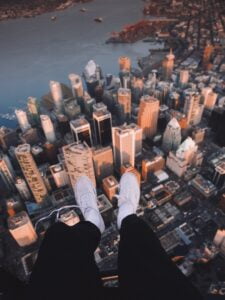While many people may be familiar with virtual reality in a gaming environment, we are putting virtual reality to work for phobia treatment! We are excited to share that we have a virtual reality headset and have been using it in our work with phobias. We’re committed to bringing this cutting edge technology to our work.

What is Virtual Reality (VR)?
Virtual reality (VR) is created by putting on a headset that creates the illusion of a 3-D environment, including sights, sounds, and vibrations. We use this headset to create different experiences for our clients. This allows people to practice tolerating anxiety and use coping skills when encountering anxiety-provoking situations. When done in the real world, this is considered exposure therapy. When used with VR, it’s referred to as virtual reality exposure therapy (VRET).
What is involved in phobia treatment?
Phobia treatment involves exposure therapy, which is about gradually facing fears. When doing exposure therapy, clients work with a therapist to break the fear down into manageable steps. Early in the process, clients may be taking very small steps to ease their way into the process. As therapy moves along, clients face bigger fears. We build confidence and people know they can handle distress using tools learned in therapy. Find out more exposure therapy here.
What are the benefits of VR for exposure therapy?
Having access to a virtual experience opens up several options.
- it can help you develop a sense of confidence by first facing fears in a safe and controlled environment. Knowing that you can pause the video or take off the headset at any time might boost your willingness to face your fear. This helps when facing fears in real life feels too overwhelming.
- VR allows us to work with conditions that are hard to manipulate in the real world. We can find exposure scenarios that target exactly what’s holding you back.
- VR allows us to do exposures that aren’t practical or possible. For example, if you have a fear of flying, it’s probably not practical to take a flight every week for exposure practice. With VR, we can do that. Other exposures just aren’t possible in real life. For example, for a fear of heights, we can simulate walking a tightrope strung between two skyscrapers.
- VR lets us practice first in a private environment so that you can build some confidence before moving to practice in the real world.
Using VR allows us to work with the following fears more effectively:
- Fear of heights
- Fear of spiders
- Fear of vomiting
- Fear of flying
- Fear of driving
- Fear of the dentist
- Blood-injection-injury fears
- Claustrophobia (fear of enclosed spaces)
- Social anxiety disorder
- Other specific phobias
- Many others!

What does the evidence say about VR for phobia treatment?
More and more studies are showing support for the use of VR for exposure therapy. A recent review paper found that 18 studies showed positive results for treating a range of phobias, including animal phobias, natural phobias, situational phobias, and blood-injection-injury phobias. The authors conclude that virtual reality-based exposure therapy is effective and is a viable alternative to exposures in real life (Albakri et al, 2022).
In a study of fear of heights, another study compared a group assigned to the VR treatment group and a control group. All participants completed the 4-week follow-up. On average, participants completed just over 2 hours of exposure. Compared with the control group, the VR treatment reduced fear of heights by 24 points (compared to 1 point in the control group) on a fear of heights questionnaire. The benefit was still present one month later (Freeman et al., 2018)
In another study, people with a fear of spiders were randomly assigned to receive either VR exposure therapy or a to waiting list. Participants in the VR treatment group received an average of four one-hour exposure therapy sessions. VR exposure was effective in treating spider phobia based on a Fear of Spiders questionnaire, a Behavioural Avoidance Test (BAT), and severity ratings made by the clinician and an independent rater. Overall, 83% of people in the VR treatment group showed clinically significant improvement compared with 0% in the waiting list group. (Garcia-Palacios et al., 2002)

How do we use it in the office?
At Anxiety Specialists of St. Louis we use a Meta Quest 2, which is a headset with two hand controllers. This headset connects to another device so that we can simultaneously view you and your reactions as well as the VR environment. This allows us to see what you see. This helps us give you coaching instructions more clearly. Clients so far have told us that the headset is comfortable.
Below are two examples of what these exposures might look like for fears of the dentist (video 1) and flying (video 2). (Big thanks to our practicum student Bailey for helping me film these.)
These are just some examples of the ways we might use these videos. Remember, doing these exposures would be part of a larger treatment program and we would do some preparation before diving right in.
One note here: if you’re prone to headaches, motion sickness, vertigo or have a history of seizures, VR may not be for your specific phobia treatment.
Overall, These studies and others suggest that VR exposure therapy is an effective treatment for a variety of phobias. VR exposure therapy is safe, convenient, and can be done in a private setting where you have a lot of control. If you are struggling with a phobia, VR exposure therapy may be a helpful treatment option for you. Please feel free to reach out to us with any questions.
